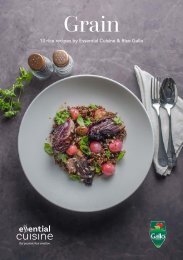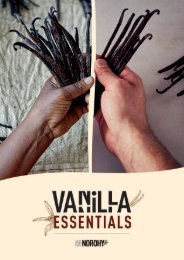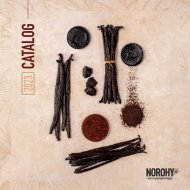You also want an ePaper? Increase the reach of your titles
YUMPU automatically turns print PDFs into web optimized ePapers that Google loves.
FIBERS AND THEIR CATEGORISATION<br />
JORDI BORDAS X<br />
Dietary fiber serves as the structural part <strong>of</strong> plants and is found <strong>in</strong> all foods derived<br />
from plant products.<br />
It is the edible part <strong>of</strong> plants that our digestive enzymes cannot break down, so fiber<br />
is not digested <strong>in</strong> the same way as sugars and starches and arrives <strong>in</strong>tact <strong>in</strong> the gut<br />
act<strong>in</strong>g as a prebiotic.<br />
Fibers can be divided <strong>in</strong>to two ma<strong>in</strong> groups accord<strong>in</strong>g to their composition.<br />
Soluble Fibers :<br />
They are found <strong>in</strong> legumes, some<br />
cereals, and fruits. They have the<br />
characteristic <strong>of</strong> absorb<strong>in</strong>g a lot <strong>of</strong><br />
water and can form viscous gels.<br />
They reduce and slow down the<br />
absorption <strong>of</strong> fats and sugars from<br />
food.<br />
Insoluble Fibers :<br />
They predom<strong>in</strong>ate <strong>in</strong> foods such<br />
as wheat bran, whole gra<strong>in</strong>s,<br />
some vegetables, and cereals.<br />
They have a low water absorption<br />
capacity and their ma<strong>in</strong> effect on<br />
the body is to clean the <strong>in</strong>test<strong>in</strong>al<br />
tract walls.<br />
In addition to the fiber naturally<br />
present <strong>in</strong> our food, we can add<br />
fiber to our recipes and products to<br />
improve the nutritional value.<br />
Accord<strong>in</strong>g to the WHO, an adult<br />
should consume between 25 and<br />
38 g <strong>of</strong> fiber per day to ma<strong>in</strong>ta<strong>in</strong> a<br />
good level <strong>of</strong> health.<br />
WHY ARE THEY INTERESTING IN PASTRY?<br />
Pastry mak<strong>in</strong>g is a discipl<strong>in</strong>e <strong>in</strong> which several technical functions are <strong>in</strong>volved, which<br />
are necessary to obta<strong>in</strong> a good result.<br />
It is difficult to imag<strong>in</strong>e a <strong>pastry</strong> mak<strong>in</strong>g process that does not <strong>in</strong>volve an emulsion,<br />
and the need to thicken or stabilise elaborations is also common, to achieve better<br />
results and improve the texture <strong>of</strong> the f<strong>in</strong>al product.<br />
Traditionally these functions have been covered by the basic <strong>in</strong>gredients, e.g., eggs,<br />
fats such as butter or cream, sugars, etc.<br />
Fibers provide a range <strong>of</strong> <strong>in</strong>terest<strong>in</strong>g options to replace or improve the technical<br />
functions <strong>of</strong> the basic <strong>in</strong>gredients.<br />
By us<strong>in</strong>g Fibers, we can obta<strong>in</strong> a <strong>pastry</strong> with a better texture, lighter, healthier, and<br />
at the same time enhance flavours, such as fruit or nuts, which can sometimes be<br />
masked by an overuse <strong>of</strong> <strong>in</strong>gredients such as egg, dairy, or sugars.<br />
7
















